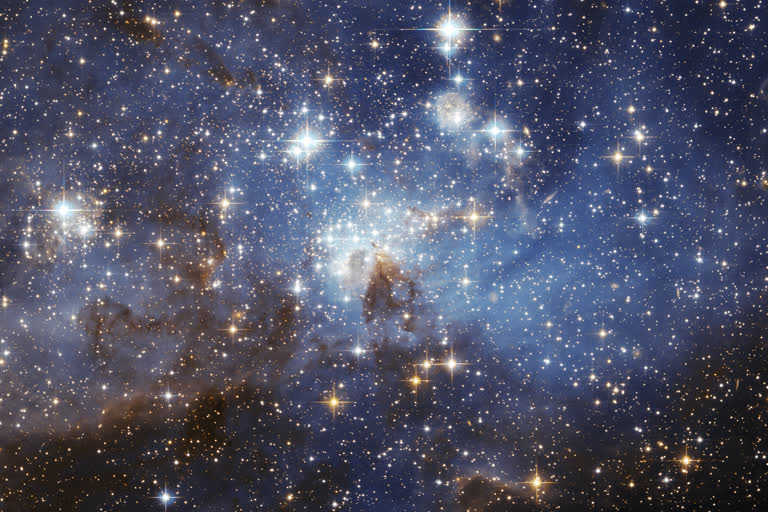New Delhi:Indian space scientists have spotted a new member belonging to the extremely rare group of young stars that exhibit episodic accretion. It means that these stars are developing into bigger stars because of the coming together and cohesion of cosmic matter under the influence of gravitation. Such rare stars have gained significant interest in the star-formation community in recent times and this study conducted by Indian space scientists could help probe this group of stars and their formation mechanism in greater detail.
What are accreting young stars?
Episodically accreting young stars are those young stars with a low mass that have not initiated hydrogen fusion in their core and are fuelled by gravitational contraction and deuterium fusion which is the pre-main-sequence phase of the star. These pre-main-sequence stars are surrounded by a disc. This disc feeds continuously on the matter from the disc-shaped region of gas and dust surrounding the star to gain mass. This process is known as mass accretion from the circumstellar disc of the star.
In this cosmic phenomenon of formation of stars what happens is that the feeding rate of these stars increases. This process is known as the periods of enhanced mass accretion from their circumstellar disc. During such episodes, the brightness of the star increases by 4-6 times in the optical bands. So far 25 such rare groups of stars have been discovered by the space scientists community.
Three Indian Institutions contributed to discovery
Indian astronomers from the Aryabhatta Research Institute of Observational Sciences (ARIES), including other scientists from the Tata Institute of Fundamental Research (TIFR) and Indian Institute of Astrophysics (IIA), have discovered Gaia 20eae, the latest member of episodically accreting young stars. Indian scientists made this discovery as part of an international effort.
Aryabhatta Research Institute is an autonomous institute under the Department of Science & Technology, Government of India. In August 2020, the Gaia Photometric Alert system– a sky survey which actively searches for the transient objects and publishes a daily report on the number of transients it detects, published a report stating that Gaia 20eae has brightened by 4.5 times. This indicated a likely case of enhanced episodic accretion.
A team of Indian scientists led by Arpan Ghosh, a Ph.D. student with Dr. Saurabh Sharma from ARIES along with Dr. Joe. P. Ninan from Pennsylvania State University, USA, Dr. DK Ojha from TIFR, Mumbai, Dr. B.C Bhatt from IIA, Bengaluru, and other space scientists from well known international universities started to monitor Gaia 20eae immediately after the detection of the alert
This group also included scientists and researchers from Princeton University, University of Oklahoma, John Hopkins University, University of California and Space Telescope Science Institute, USA, National Astronomical Research Institute of Thailand, and Macquarie University, Australia.
India’s contribution to discovery
The team of astronomers carried out simultaneous photometric and spectroscopic observations using Indian facilities like the 1.3m Devasthal Fast Optical Telescope, 3.6m Devasthal Optical Telescope, 2m Himalayan Chandra Telescope, and international facilities like 10m HET telescope and 0.5m ARC Small Aperture Telescope. These scientists and researchers observed that the light curve of Gaia 20eae showed a transition stage when it exhibited most of its brightness at a short timescale of 34 days with a very rapid rising rate (3 mag/month).
Gaia 20eae has now started to decay. The team has detected strong signatures of outflowing winds generated due to increased accretion and the presence of turbulence around Gaia 20eae. In what is a first-time discovery, the team detected a signature of magnetospheric accretion (red-shifted absorption) component from the high-resolution spectra (in Ca II IR triplet lines).
This was consistent with the signature of low-velocity in-fall of matter from the inner part of the surrounding disc onto the central pre-main sequence star as viewed from a hotter background. The investigation of Gaia 20eae by Indian and international scientists points towards magnetospheric accretion being the phenomenon for the current outburst. This is the first-time discovery because of the location of Gaia 20eae in the sky which enabled the team to view the low-velocity red−shifted absorption signature on top of the broad Ca II IR triplet emission line.
This research, which has been published in the Astrophysical Journal, provides an important test-bed to probe the various physical aspects of episodic accretion and their comparison with previously discovered sources.
